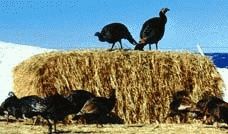HAY BALES LURE NUISANCE TURKEYS AWAY FROM FARMS, RANCHES
Published 12:00 am Friday, January 24, 2003

- POPULAR DRAW:Rio Grande turkeys are being drawn to bales like this one in Union County. The bales contain wheat, oats and peas. ().
By Dick Mason
Observer Staff Writer
It is a sight that some people could not have foreseen 20 years ago turkeys and elk breaking bread together in Northeast Oregon.
No, turkeys and elk are not Diner’s Club partners, but they are occasionally eating together this winter.
The animals are sharing "turkey bales” being put out in Northeast Oregon. The bales are distributed in Union, Wallowa and Baker counties as part of a program designed to prevent wild turkeys from becoming a winter nuisance for landowners. The program is run by the Oregon Department of Fish and Wildlife and funded by the National Wild Turkey Federation.
"It is going well,” said Eddie Miguez, the Oregon Department of Fish and Wildlife’s manager of the Elkhorn Wildlife Area.
The bales are placed where landowners are having problems with turkeys converging on their land and becoming a nuisance. The bales are proving successful in drawing turkeys away from the property of farmers and ranchers.
This is the second year that turkey bales have been put out in Union County. Miguez noted that turkeys took a little time to find the bales last winter because they were not used to them. However, this year they quickly found them.
Elk are occasionally joining turkeys at the bales, which contain wheat, peas and oats. This is not a competitive situation since elk eat the straw and the turkeys consume the peas and oats, Miguez said.
Bull elk actually help the turkeys because they stick their horns through the bales and loosen the peas and oats in the process.
In some situations, though, too many elk are coming to the turkey bales. Panels have been set up to keep elk away.
Many of the bales are placed under tree stands to prevent them from being covered with snow, Miguez said.
Many people could not have imagined two decades ago that wild turkeys would someday be a nuisance in Northeast Oregon. Efforts to transplant Merriam’s turkeys had been unsuccessful up to that point. In the mid-1980s, however, Rio Grande turkeys were released in Northeast Oregon. The bird adapted quickly and today their numbers are soaring in Wallowa, Union and Baker counties.
The increase in the turkey population causes problems only in the winter when the birds visit farms and ranches in search of food. The birds can become a nuisance when they do things like sit on cars.
Keeping nature in nature
Bales are placed only in areas where turkeys will not bother people or cause problems with property, ODFW biologist Leonard Erickson said. Care is taken not to unnaturally concentrate turkeys.
The birds could be diverted by feeding them corn in areas away from humans. Setting out bales is preferable because turkeys have to work to get peas and oats from the bales, much as they do in the wild.
"They have to peck and scratch. It is a natural process,” Erickson said.
The biologist also likes the bales because they can serve as a food source for turkeys for weeks. This means that people have to come to the site less frequently to keep the food supply full.
"The bales are low maintenance, you don’t have to throw grain out every day,” Erickson said.
Miguez said that the bales limit the turkeys’ interaction with people and prevents them from becoming "semi domesticated.”
Erickson stressed that the sole purpose of the turkey bale program is to help landowners.
"It is not a feeding program,” he said.
Those who have helped distribute the turkey bales in Union County include members of the Oregon Hunters Association.
One of the key providers of turkey bales in Northeast Oregon is Chris Heffernan of North Powder. He produces many of the custom-made bales used in Union County.
"It’s a privilege to work with so many great people (in the program),” Heffernan said.
The program was originally started in the Midwest four years ago by the National Wild Turkey Federation. Known as the Big Sky program, it has since expanded to many states. The NWTF saw a need for the program because man is encroaching on winter feeding areas of wildlife throughout the nation.
"The best winter feeding ranges often have people on them … We are trying to find ways to alleviate perceived or developing problems with wintering turkeys,”’ said Mike Carey, a regional supervisor for the National Wild Turkey Federation who is based in Bend.
He added that Big Sky is not a winter feeding program. He also stressed that the National Wildlife Turkey Federation only provides funding for the program in Oregon. The NWTF is not involved in helping the ODFW run the program.
In the past when turkeys caused problems the ODFW would sometimes trap and move them to another part of Northeast Oregon. Erickson said that the program allows turkeys to remain in an area without being a nuisance. More turkeys will be in these areas for the spring hunting season as a result, Erickson said.





